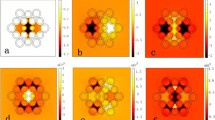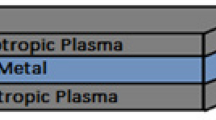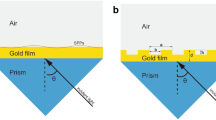Abstract
In this paper, we propose a novel sub-wavelength plasma structure that can effectively enhance surface plasmon resonance (SPR) to achieve a significant local field. On the basis of a plasma ring structure, we add a slit and two thin plasma layers, working as a metal-insulator-metal (MIM) waveguide at a specific incident wave frequency and generate the Fabry-Perot resonance (FPR). The structure thus couples the incident wave energy to the vicinity of the slit and intensifies the SPR inside the plasma ring. In addition, we also find the coupling and competing between SPR and FPR. For the coupling mode, the average field enhancement in the ring is up to a factor of 9.7. Moreover, the optimized thickness of the plasma layer is much thinner than the skin depth of the plasma to ensure the incident wave easily entering the MIM waveguide. We further calculate the dispersion relationship of surface plasmon polaritons in the waveguide cavity. The simulation results and theoretical dispersion function are in good agreements.





Similar content being viewed by others
References
Bliokh YP, Brodsky YL, Chashka KB, Felsteiner J, Slutsker YZ (2010) Broad-band polarization-independent absorption of electromagnetic waves by an overdense plasma. Phys Plasmas 17:083302
Bliokh YP, Felsteiner J, Slutsker YZ (2005) Total absorption of an electromagnetic wave by an overdense plasma. Phys Rev Lett 95:165003
Sternberg N, Smolyakov AI (2009) Resonant transmission of electromagnetic waves in multilayer dense-plasma structures. IEEE Trans Plasma Sci 37:1251–1260
Prinsloo DS, Maaskant R, Ivashina MV, Meyer P (2014) Mixed-mode sensitivity analysis of a combined differential and common mode active receiving antenna providing near-hemispherical field-of-view coverage. IEEE Trans Antennas Propag 62:3951–3961
Brauner T, Vogt R, Bachtold W (2003) A differential active patch antenna element for array applications. IEEE Microw Compon Lett 13:161–163
Padros N, Ortigosa JI, Baker J, Iskander MF, Thornberg B (1997) Comparative study of high-performance GPS receiving antenna designs. IEEE Trans Antennas Propag 45:698–706
Chen K, Yang Z, Feng Y, Zhu B, Zhao J, Jiang T (2015) Improving microwave antenna gain and bandwidth with phase compensation metasurface. AIP Adv 5:067152
Duerr W, Menzel W, Schumacher H (1997) A low-noise active receiving antenna using a SiGe HBT. IEEE Microw Guid Wave Lett 7:63–65
Patterson CE, Khan WT, Ponchak GE (2012) A (2012) 60-GHz active receiving switched-beam antenna array with integrated Butler matrix and GaAs amplifiers. IEEE Trans Microw Theory Tech 60:3599–3607
Messiaen AM, Vandenplas PE (1967) Theory and experiments of the enhanced radiation from a plasma-coated antenna. Electron Lett 3:26–27
Wang CS, Li XA, Jiang BH (2015) The enhancement mechanism of thin plasma layer on antenna radiation. Appl Phys Lett 106:102901
Kong FR et al (2018) Studies on omnidirectional enhancement of giga-hertz radiation by sub-wavelength plasma modulation. Plasma Sci Technol 20:014017
Kong FR et al (2018) Experimental and numerical studies on the receiving gain enhancement modulated by a sub-wavelength plasma layer. Plasma Sci Technol 20:095504
Sugai H, Ghanashev I (1998) High-density flat plasma production based on surface waves. Plasma Sci Technol 7:192–205
Xu X, Liu F (2008) Visual phenomena of surface plasmon polaritons at the dielectric-plasma interface. Appl Phys Lett 92:011501
Sakhnenko NK, Stogniy NP (2011) Near-field pattern images of a cylindrical plasma column. IEEE trans. Plasma Sci 39:2552–2553
Zhang L, Ouyang JT (2016) Numerical investigation of a microwave-band surface plasmon excited on an overdense plasma cylinder. J Appl Phys 49:195105
Aizpurua J, Hanarp P, Sutherland DS, Kall M, Bryant W, García de Abajo FJ (2003) Optical properties of gold nanorings. Phys Rev Lett 90:057401
Love JC, Gates BD, Wolfe DB, Paul KE, Whitesides GM (2002) Fabrication and wetting properties of metallic half-shells with submicron diameters. Nano Lett 2:891–894
Charnay C, Lee A, Man S-Q, Moran CE, Radloff C, Bradley RK, Halas NJJ (2003) Reduced symmetry metallodielectric nanoparticles: chemical synthesis and plasmonic properties. Phys Chem B 107:7327–7333
Lu Y, Liu GL, Kim J, Mejia YX, Lee LP (2005) Nanophotonic crescent moon structures with sharp edge for ultrasensitive biomolecular detection by local electromagnetic field enhancement effect. Nano Lett 5:119–124
Mansuripur M, **e Y, Zakharian AR et al (2004) Transmission of light through slit apertures in metallic films. Opt Express 12:6106–6121
Miyazaki HT, Kurokawa Y (2006) Squeezing visible light waves into a 3-nm-thick and 55-nm-long plasmon cavity. Phys Rev Lett 96:097401
Cui Y, He S (2009) Enhancing extraordinary transmission of light through a metallic nanoslit with a nanocavity antenna opt. Lett. 34:16–18
Qiu SL, Li YP, J. (2009) Q-factor instability and its explanation in the staircased FDTD simulation of high-Q circular cavity. Opt Soc Am B 26:1664–1674
Economou EN (1969) Surface plasmons in thin films Phys. Rev. 182:539–554
Funding
This work has been supported partially by the National Natural Science Foundation of China (Grant Nos. 1187050396, 11875118, 41674165).
Author information
Authors and Affiliations
Corresponding author
Additional information
Publisher’s Note
Springer Nature remains neutral with regard to jurisdictional claims in published maps and institutional affiliations.
Rights and permissions
About this article
Cite this article
Qu, B., Wang, X., Li, B. et al. Surface Plasmon Resonance Intensification by Cavity-Ring Plasma Structure in the Giga-Hertz Regime. Plasmonics 15, 1591–1597 (2020). https://doi.org/10.1007/s11468-020-01180-0
Received:
Accepted:
Published:
Issue Date:
DOI: https://doi.org/10.1007/s11468-020-01180-0




